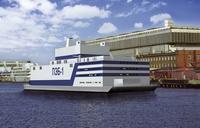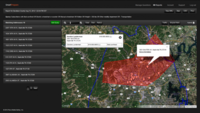-
Start-ups offer law enforcement innovation, flexibility, and low prices
Start-ups offer innovation and flexibility in addition to lower price points. The influx of start-ups into the law enforcement and security supply market is in its early stage, and while few start-ups have begun to compete with traditional, and much larger, players, law enforcement units appear to be attracted to the innovation and lower prices offered.
-
-
Mobile phone use a significant security risks for companies
New research suggests that companies are leaving themselves open to potentially serious security and legal risks by employees’ improper use of corporate mobile devices. Experts looked at a sample of mobile phones returned by the employees from one Fortune 500 company and found that they were able to retrieve large amounts of sensitive corporate and personal information. The loss of data such as this has potential security risks, inviting breaches on both an individual and corporate level.
-
-
Scientists: Shale oil and gas may not be U.S. energy salvation
After ten years of production, shale gas in the United States cannot be considered commercially viable, scientists say. They argue that while the use of hydraulic fracturing and horizontal drilling for “tight oil” is an important contributor to U.S. energy supply, it is not going to result in long-term sustainable production or allow the United States to become a net oil exporter.
-
-
Russia to build floating nuclear power plants

Global warming is opening the Arctic Ocean to shipping – and causing the rapid melting of Arctic ice. Russia says that ship-based nuclear power plants would allow it to provide power to remote cities in Siberia, and provide power to oil and gas drilling operations in the Arctic (about 30 percent of the world’s unclaimed natural gas is in the Arctic, and about, 60 percent of that unclaimed natural gas is in the Russian Arctic). Experts worry about the ability of ship-based nuclear reactor to withstand extreme weather events, or terrorist attacks. The U.S. Army deployed its own floating nuclear reactor – the Sturgis – in the Panama Canal Zone from 1968 to 1976.
-
-
Cyphort, a threat monitoring specialist, raises $15.5 million Series B funding
San Jose, California-based Cyphort, Inc., a company specializing in advanced threat monitoring and mitigation platform, has closed in $15.5 million Series B funding. The round was led by Menlo Park, California-based Trinity Ventures with participation from existing investors Foundation Capital and Matrix Capital. Cyphort’s platform blends multi-phase behavioral analysis, machine learning, and correlation to provide businesses with real-time detection, context, and mitigation for advanced malware attacks that bypass traditional security and first generation APT solutions.
-
-
NIST seeks public comments on updated smart-grid cybersecurity guidelines
The National Institute of Standards and Technology (NIST) is requesting public comments on the first revision to its guidelines for secure implementation of “smart grid” technology. The draft document, NIST Interagency Report (IR) 7628 Revision 1: Guidelines for Smart Grid Cybersecurity, is the first update to NISTIR 7628 since its initial publication in September 2010.
-
-
Where should U.S. radioactive waste be buried?
In the United States, about 70,000 metric tons of spent commercial nuclear fuel are located at more than seventy sites in thirty-five states. Shales and other clay-rich (argillaceous) rocks have never been seriously considered for holding America’s spent nuclear fuel, but it is different overseas. France, Switzerland, and Belgium are planning to put waste in tunnels mined out of shale formations, and Canada, Japan, and the United Kingdom are evaluating the idea.
-
-
Arkansas deploys first statewide SmartPrepare system

Arkansas uses citizen-supplied data for more efficient emergency planning and response. The service allows citizens to create secure profiles online which contain vital details about their household. Public safety officials can use the data to gain greater insight into their communities and identify potential challenges in order to prepare more effectively for disasters, allocate resources, and expedite emergency response and recovery efforts during events.
-
-
DDoS protection specialist Black Lotus raises $3.5 million
San Francisco-based Black Lotus, a DDoS protection specialist, last week announced the completion of its first institutional financing in the amount of $3.5 million. The round was led by San Francisco-based Industry Capital. The strategic investment will fund entry into new markets, where Black Lotus will deploy additional capacity and improve quality of service through peering and closer proximity to global partner networks.
-
-
Sharp increase in radioactive water leaks at Fukushima
Tokyo Electric Power(TEPCO) has reported a rise in groundwater radiation levels, saying a tank at the firm’s Fukushima plant leaked 300 metric tons of toxic water in August 2013. Water samples from wells, taken in mid-October, show a record-high concentration of beta-ray emitting substances, and a sharp increase in the presence of radioactive tritium. Japanese prime ministerShinzo Abe, in a tacit admission that Japan cannot effectively handle the continuing radiation leaks from the stricken plant, said Japan would be interested in receiving foreign help to contain widening radioactive water leaks at Fukushima.
-
-
Preventing a Bhopal-like catastrophe in New Jersey
New Jersey is home to ninety facilities which produce and store large quantities of highly toxic chemicals. A superstorm or terrorist attack could doom millions of people around southern New Jersey and eastern Pennsylvania to a Bhopal, 1984-like fate if either of these facilities and their storage tanks were affected.Typically, in the aftermath of major disasters, a blue ribbon panel is created to review preventative measures that could have been taken before the disaster. Security experts say that there is no need to wait for a post-disaster blue ribbon panel investigation to know what sensible safety measures should be implemented now.
-
-
Terrorism insurance should cover cyberterrorism: industry

The Terrorism Risk Insurance Act(TRIA) is a federal backstop designed to protect insurers in the event an act of terrorism results in losses above $100 million. Industry officials question whether cyber terrorism is covered by the program, which is administered by the Treasury Department. Industry insiders note that terrorism risks have evolved since TRIA was enacted and cyberterrorism is now a real threat. TRIA should thus not simply be reauthorized with a blanket stamp of approval; instead there should be a discussion about whether acts of cyberterrorism should be explicitly included in TRIA.
-
-
NIST releases Preliminary Cybersecurity Framework
The National Institute of Standards and Technology (NIST) on Tuesday released its Preliminary Cybersecurity Framework to help critical infrastructure owners and operators reduce cybersecurity risks in industries such as power generation, transportation, and telecommunications. In the coming days, NIST will open a 45-day public comment period on the Preliminary Framework and plans to release the official framework in February 2014.
-
-
Violin Memory: Winning over the intelligence community

Violin Memory (NSYE: VMEM) is a recently IPO’d enterprise flash memory provider that has won installations across the most demanding branches of government, particularly in intelligence and homeland security. One advantage the company holds is a partnership with Toshiba, the world’s #2 manufacturer of NAND, which reportedly gives Violin insider-access to the unpublished R&D data, allowing for a product that has steadily performed steps ahead of the competition. The partnership also allows Violin to buy NAND at special “producer-like” prices from Toshiba, which in turn has enabled Violin to price more competitively, up to 50 percent lower than other providers. What is clear is that Violin’s technology adoption is growing exponentially within the security sector and other areas where data performance cannot be compromised and is mission critical.
-
-
Cybersecurity specialist Bromium raises $40 million Series C funding
Cupertino, California-based Bromium, Inc. has raised $40 million in an Series C funding round led by new investor Meritech Capital Partners, with participation from existing investors Andreessen Horowitz, Ignition Partners, Highland Capital Partners, and Intel Capital. Bromium offers advanced malware protection and automated forensic intelligence products. Bromium’s vSentry uses Intel CPU and chipset features to hardware-isolate tasks that access the Web, attachments, and files that might contain malware, protecting the desktop by design.
-
More headlines
The long view
Factories First: Winning the Drone War Before It Starts
Wars are won by factories before they are won on the battlefield,Martin C. Feldmann writes, noting that the United States lacks the manufacturing depth for the coming drone age. Rectifying this situation “will take far more than procurement tweaks,” Feldmann writes. “It demands a national-level, wartime-scale industrial mobilization.”
Trump Is Fast-Tracking New Coal Mines — Even When They Don’t Make Economic Sense
In Appalachian Tennessee, mines shut down and couldn’t pay their debts. Now a new one is opening under the guise of an “energy emergency.”
Smaller Nuclear Reactors Spark Renewed Interest in a Once-Shunned Energy Source
In the past two years, half the states have taken action to promote nuclear power, from creating nuclear task forces to integrating nuclear into long-term energy plans.
